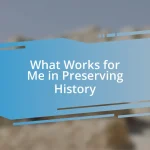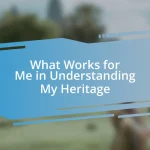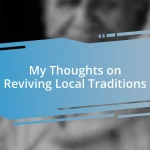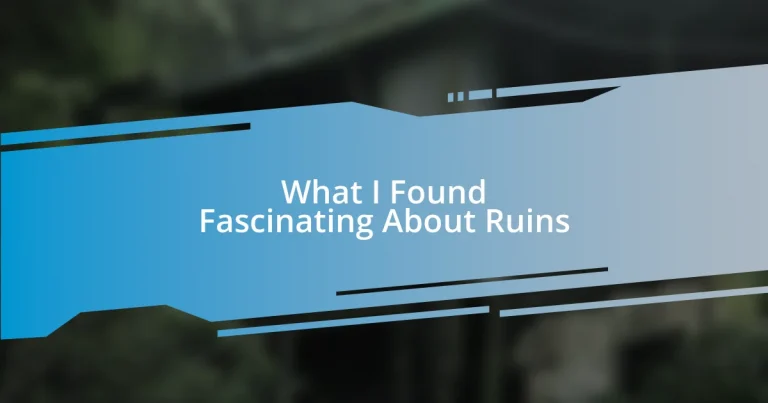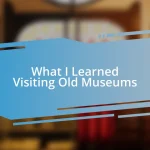Key takeaways:
- Ruins evoke deep emotional connections and reflections on the transient nature of human experiences, prompting curiosity about the lives once lived there.
- They serve as significant historical links, showcasing achievements and cultures while offering insights into daily life and architectural ingenuity.
- Preservation and restoration require balancing authenticity with modern needs, raising ethical questions about how to respect the original story while making heritage accessible for future generations.
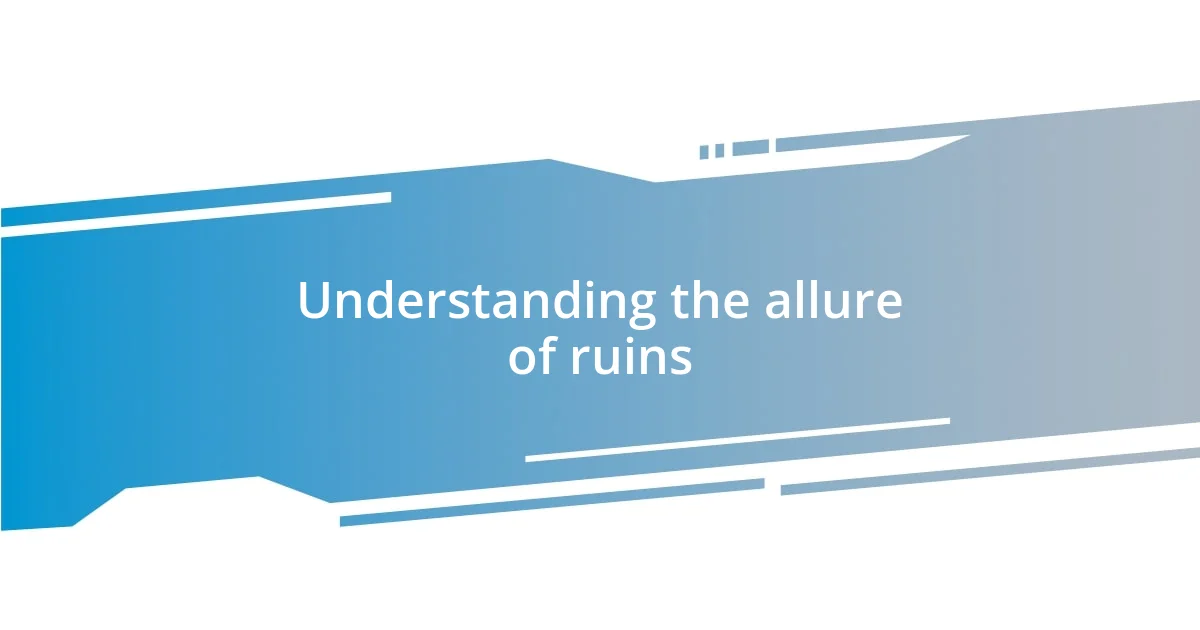
Understanding the allure of ruins
Ruins have an uncanny ability to evoke powerful emotions, don’t they? I remember visiting an ancient castle, its stone walls weathered and crumbling, yet still standing proudly amid the landscape. It struck me that these remnants of the past tell stories of lives lived and dreams once cherished, creating a deep sense of connection with history.
There’s something profoundly introspective about wandering through a decaying structure. As I explored a forgotten monastery once bathed in the laughter of monks, I felt an almost surreal silence envelop me. What was it about that stillness that ignited a tangle of emotions within me, making me ponder how many seasons had passed since joy echoed through those now-empty halls?
In my experience, the allure of ruins often stems from their ability to ignite curiosity. When I stood before the remnants of a once-thriving village, I couldn’t help but wonder about the families who lived there. What challenges did they face? What dreams did they nurture? It’s this rhythm of questions and reflections that draws us to these silent sentinels of history, reminding us of the transient nature of life itself.
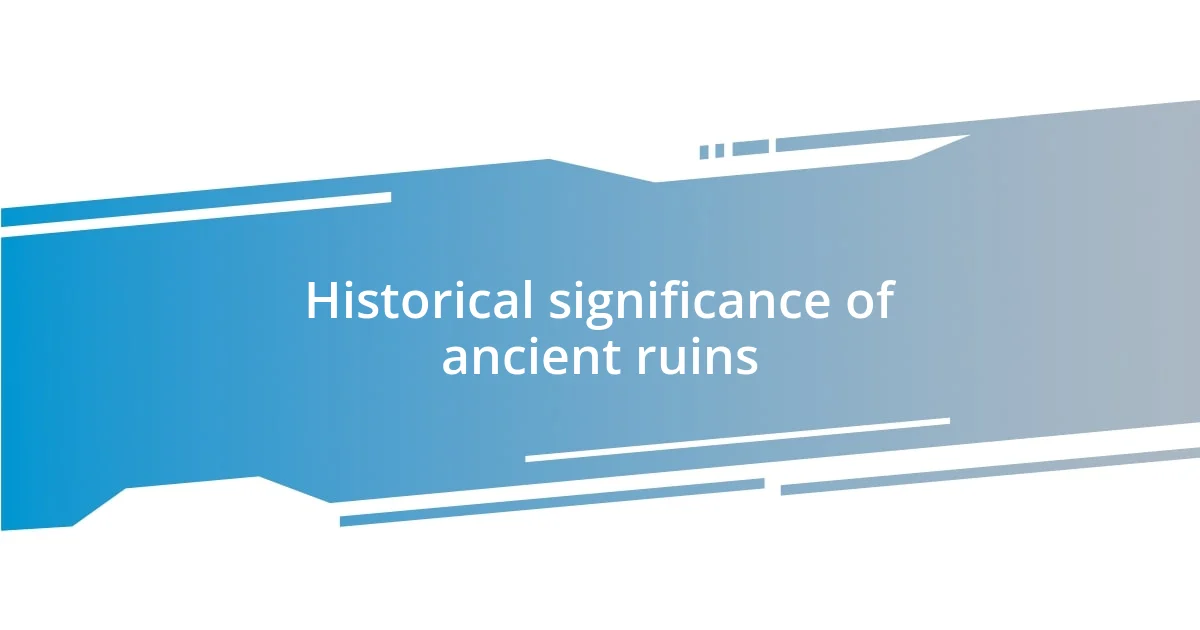
Historical significance of ancient ruins
Walking through ancient ruins, I often feel a profound connection with the generations that came before us. Each crack in the stone, each weathered column, whispers stories of resilience and change, drawing me into the tapestry of human experience. It’s almost like time traveling; the ghosts of past lives linger, revealing the cultures that shaped our world.
- They serve as tangible links to our history, reminding us of achievements and failures.
- They tell stories of technological advancements, social structures, and artistic expression.
- I’ve found that many ancient ruins also offer insights into daily life, from the layout of a city to the remnants of trade routes.
- Walking among these ruins invites a moment of reflection on how far we’ve come and where we might be headed next.
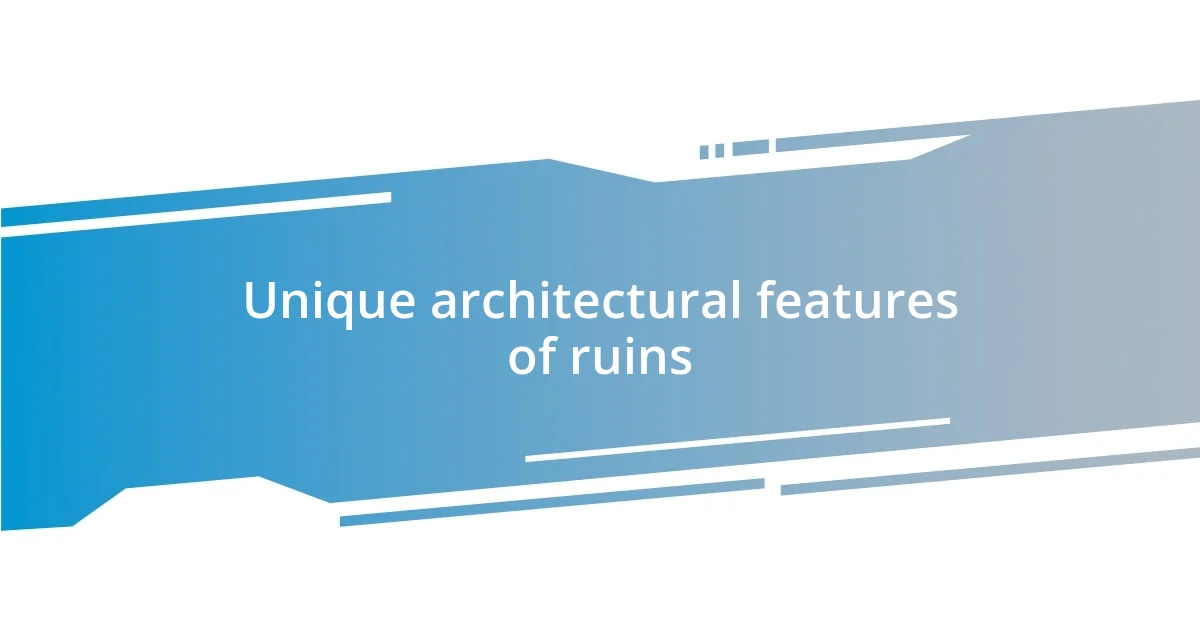
Unique architectural features of ruins
The unique architectural features of ruins often reveal the ingenuity and craftsmanship of past civilizations. For instance, I’ve marveled at the way ancient Greek temples, despite their dilapidation, still showcase the beauty of Doric columns. They stand as impressive relics, highlighting the Greeks’ understanding of symmetry in design, and I found myself imagining the skillful hands that carved these structures centuries ago.
One of the most fascinating aspects of ruins is their blend of nature and architecture. When I wandered through the overgrown remnants of a Mayan city, I was captivated by how the jungle embraced the stone walls. Vines cascaded over the weathered blocks, creating a stunning contrast between the man-made and the natural world. It made me ponder the resilience of nature, and how it gracefully reclaims its territory over time.
However, it’s the intricate details often overlooked that really resonate with me. I remember standing before the crumbling façade of a Roman aqueduct, noticing small engravings that had weathered years of exposure. Each mark seemed like a whisper from the past, telling tales of the daily lives of those who relied on this ingenious water transport system. It’s these small, often unseen features that enhance the narrative of ruins, revealing the everyday lives of people long gone.
| Unique Features | Significance |
|---|---|
| Doric Columns | Symbolize Greek architectural excellence |
| Nature Embedding | Highlights the harmony between architecture and the environment |
| Intricate Engravings | Provide insights into daily life and craftsmanship |

Cultural stories behind famous ruins
When visiting the ruins of Machu Picchu, I was struck by the stories etched into every rock. The Incas constructed this wonder not just as a city but as a spiritual sanctuary, reflecting their beliefs and connection to the mountains. I couldn’t help but wonder, how did they manage to create such harmony between their architecture and nature? Standing there, surrounded by the misty peaks, I truly felt the weight of their culture’s legacy resting on my shoulders.
Exploring the ancient Roman Colosseum left me with a sense of awe and somber reflection. It served as a grand arena for gladiatorial combat, yet it also symbolized the social and political dynamics of its time. I imagined the roars of the crowd and the intense atmosphere that must have gripped those spectators. What drove people to witness such violence? Those who walked its halls carried stories of bravery, triumph, and tragedy that reverberated through the ages.
Then there’s the haunting beauty of Angkor Wat, where the intricate carvings along its walls tell stories of Hindu mythology and royal exploits. As I traced my fingers over the intricately detailed bas-reliefs, I felt an immediate connection to the artisans who poured their souls into this masterpiece. What were their lives like, I wondered? The ruins are not merely remnants of the past; they encapsulate an entire culture’s identity, inviting us to uncover the vibrant stories that shaped their world.

Emotional connections to ruins
Standing amidst the ruins of an ancient castle, I could almost hear the echoes of laughter and the clinking of goblets in the great hall. The stones felt alive with memories, each one a silent witness to both celebrations and betrayals. Isn’t it fascinating how a mere structure can evoke such a strong emotional response? For me, it highlights the transient nature of human experiences and the stories that linger long after the people have gone.
During a visit to the remains of a forgotten village, a sense of solitude washed over me, mingling with an intense curiosity about its former inhabitants. I couldn’t help but wonder: what were their daily lives like? What dreams and struggles unfolded in those now-silent streets? It struck me that these ruins are not merely remnants of an era; they serve as poignant reminders urging us to reflect on our own lives and connections.
As I meandered through the skeletal remains of a once-bustling marketplace, I felt a profound sense of loss, almost as if I was mourning for a place filled with vibrant life and commerce. The air was thick with untold stories—the laughter of children playing, the haggling of merchants, the scent of spices wafting through the air. In that moment, I realized that ruins encapsulate not just history but a deep emotional fabric woven from myriad human experiences, both joyful and sorrowful.
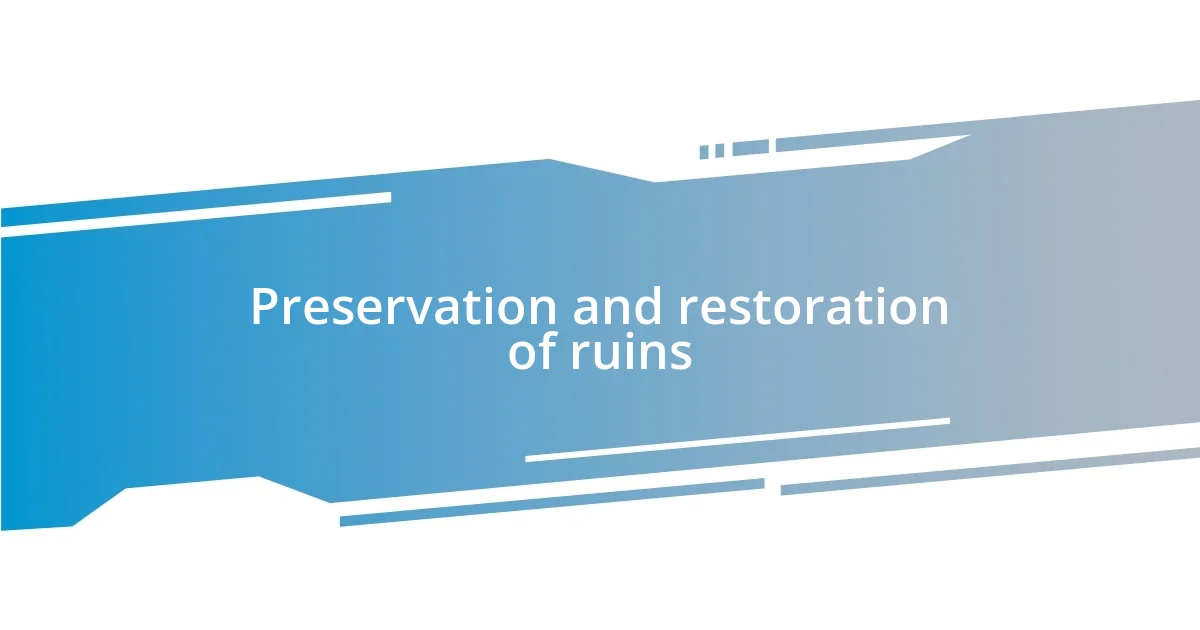
Preservation and restoration of ruins
The preservation and restoration of ruins often evoke a sense of responsibility and care; after all, these structures are like fragile time capsules holding the weight of history. I remember visiting the Acropolis in Athens and marveling at the ongoing efforts to restore the Parthenon. Witnessing skilled artisans carefully replacing and reinforcing stones made me appreciate just how vital it is to protect our cultural heritage. Isn’t it remarkable how, through modern techniques, we can breathe new life into something that has stood the test of time?
Yet, preserving ruins isn’t solely about maintaining bricks and mortar; it’s about balancing authenticity with modern needs. During a trip to the ruins of Pompeii, I learned that some preservation measures aim to protect against weathering while maintaining the site’s historical integrity. I couldn’t help but wonder: how do restorers decide which aspect of the ruin to preserve or emphasize? Each choice reflects a deep understanding of history as well as a desire to connect visitors with the past in a meaningful way.
Sometimes, the process of restoration raises ethical questions. When I was at the ancient city of Ephesus, I encountered a beautifully restored theatre bustling with tourists. It’s impressive, yet I felt a twinge of discomfort knowing it was once a site of Roman spectacles—would its restoration overshadow the authenticity of its past? This brings to light a crucial point in the preservation conversation: how do we respect the original story while making it accessible for future generations to experience? These considerations make each project an intricate dance between history and the present, rich with implications for how we understand our shared heritage.
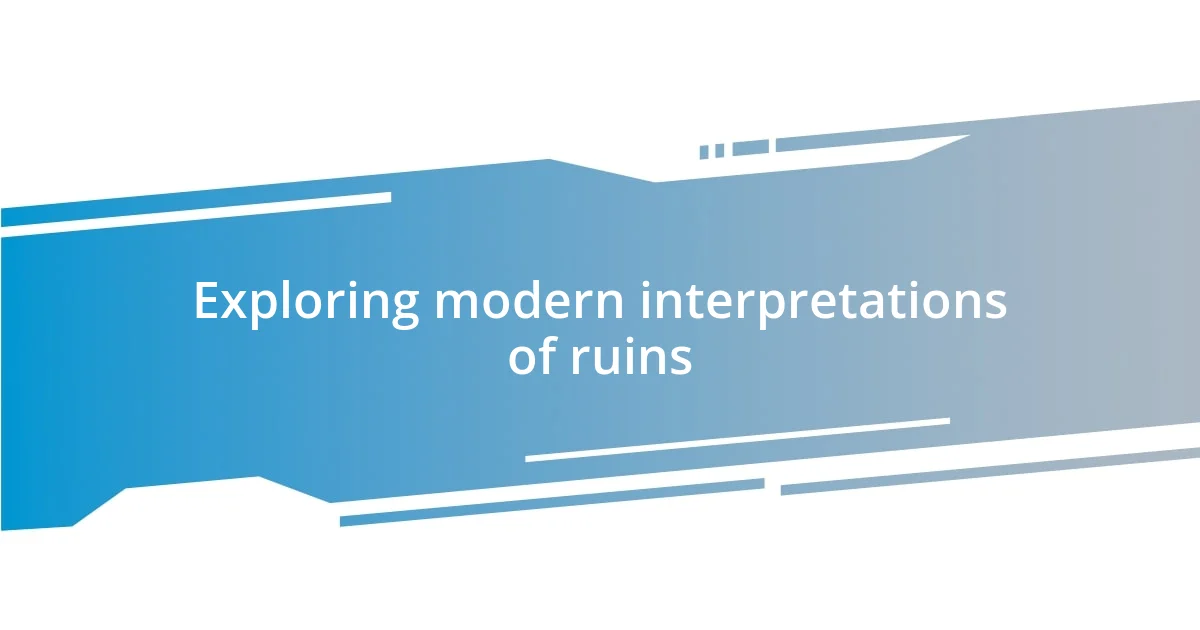
Exploring modern interpretations of ruins
Exploring modern interpretations of ruins often reveals how these remnants can spark creative expression. I once stumbled upon an art exhibit inspired by the crumbling walls of an ancient fort. The artists had integrated multimedia elements that felt like a dialogue with the past, blending contemporary art with the whispers of history. Isn’t it intriguing how creators today can take a physical space and transform it into a canvas for storytelling, transcending time?
In my experience visiting sites like the Roman Forum, I witnessed how ruins can serve as a backdrop for reimagining cultural identity. The juxtaposition of modern life against the remnants of ancient architecture creates a powerful narrative. For many, this fusion invites a sense of belonging—a reminder that while our surroundings may change, our connection to history remains deeply rooted. Have you ever felt that surge of identity while standing in a space that tells a story far beyond your own?
I also find it fascinating how ruins act as a lens through which we examine contemporary issues, such as climate change and urbanization. During an expedition to the hauntingly beautiful ruins of Tulum, I reflected on the fragility of human achievements in the face of nature’s forces. The crumbling structures on those cliffs evoke thoughts about sustainability and preservation. It makes you wonder: can modern society learn from the stories written in stone? Each time I visit these places, I come away with more questions, urging me to contemplate our role in preserving not just the ruins themselves but the lessons they impart.
